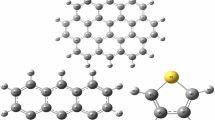Abstract
A group of aromatic compounds (benzene, naphthalene, anthracene, and tetracene) was selected to design four sheets of graphene based on quantum mechanics calculations using the density function theory (DFT), leaning on the cyclic polymerization mechanism. Theoretical results offer that graphene-I is the most stable depending on the values of EHOMO (− 4.91601 eV), gap energy (2.76549 eV), and total energy (− 3447.42377654 a.u.). The thermodynamic theoretical outcome showed that all reactions are exothermic and spontaneous. Graphene is a two-dimensional plane, so the nanotube design process is with two possibilities: the first about the x-axis (horizontal (H)) and the second about the y-axis (vertical (V)). The theoretical results gave two groups: the first gave more stability to graphene at the expense of the nanotubes prepared from it, namely, graphene-I and the second gave less stability to graphene compared to the nanotubes prepared from it, namely, graphene-II, graphene-III, and graphene-IV), depending on the energy of HOMO and gap energy. The value of gap energy ranged (from 1.10370 to 1.79922 eV) for the following compounds (graphene-II, nanotube-II-V, nanotube-III-H, and nanotube-IV-V), making those important compounds in solar cells. These theoretical results showed the possibility of preparing graphene and then nanotubes from aromatic compounds, giving the benefit of doubling the preparation of new compounds with important applications and at the same time eliminating aromatic compounds harmful to the environment.





Similar content being viewed by others
Data availability
The datasets generated during and/or analyzed during the current study are available from the corresponding author on reasonable request.
References
Heimann RB, Evsyukov SE, Koga Y (1997) Carbon allotropes: a suggested classification scheme based on valence orbital hybridization. Carbon 35:1654–1658
Novoselov KS, Geim AK, Morozov S, Jiang D, Zhang Y, Dubonos SV, Grigorieva IV, Firsov AA (2004) Electric field effect in atomically thin carbon films. Science 306(5696):666–669. https://doi.org/10.1126/science.1102896
Nair RR, Balake P, Grigorenka AN, Noveselov KS, Booth TJ, Stauber T, Pers NMR, Geim AK (2008) Fine structure constant defines visual transparency of grapheme. Science 320(5881):1308. https://doi.org/10.1126/science.1156965
Moosa AA, Ramazani A, Kubba F, Raad M (2017) Synergetic effects of graphene and nonfunctionalized carbon nanotubes hybrid reinforced epoxy matrix on mechanical, thermal and wettability properties of nanocomposites. Am J Mater Sci 7(1):1–11. https://doi.org/10.5923/j.materials.20170701.01
Tanugi DC, Grossman JC (2012) Water dasalination across nanoporous graphene. Nano Lett 12(7):3602–3608. https://doi.org/10.1021/nl3012853
Yin Z, Wu S, Zhou X, Huang X, Zhang Q, Boey F, Zhang H (2010) Electrochemical deposition of ZnO nanorodson transparent reduced graphene oxide electrodes for hybrid solar cells. Small 6(2):307–312. https://doi.org/10.1002/smll.200901968
Iijima S (1991) Helical microtubules of graphitic carbon. Nature 354:56–58
Ajayan PM (1999) Nanotubes from carbon. Chem Rev 99:1787–1799
De Heer WA, Chatelain A, Ugarte D (1995) A carbon nanotube field-emission electron source. Science 270(5239):1179–1180
Zandonella C (2001) Researchers trying to turn nanotubes into storage systems for hydrogen fuel are finding that corporate funding and academic openness can be hard to combine. Catherine Zandonella delves into a carbon controversy. Nature 410:734–735
Jiang JW, Wang JS, Li B (2009) Young’s modulus of graphene: a molecular dynamics study. Phys Rev B 80:113405. https://doi.org/10.1103/PhysRevB.80.113405
Frisch MJ, Trucks GW, Schlegel HB et al (2013) Gaussian 09W (Revision D01). Gaussian Inc., Wallingford CT, USA
Becke AD (1993) Density-functional thermochemistry—III The role of exact exchange. J Chem Phys 98(7):5648–5652
Lee C, Yang W, Parr RG (1988) Development of the Colle-Salvetti correlation-energy formula into a functional of the electron density. Phys Review 37:785–789
Obayes HR, AL-Gebori AM, Khazaal SH, Jarad AJ, Alwan GH, Al-Amiery AA (2015) Hypothetical design of carbon nanotube materials based on [8]-circulene. J Nanoelectron Optoelectron 10:711–716. https://doi.org/10.1166/jno.2015.1816
Issa AA, Obayes HR (2020) Capture carcinogenic aromatic compounds by the design of new tweezer compounds: a theoretical study. J Mole Modeling 26 (10) 292:1–6. https://doi.org/10.1007/s00894-020-04558-3
Obayes HR, Al Azawi KF, Khazaal SH, Al-wan GH, Al-Gebori AM, Al-Hamadani AH, Al-Amiery AA (2016) Theoretical studies on electrophilic aromatic substitution reaction for 8-hydroxyquinoline. Oriental J Chem 32(1):253–260. https://doi.org/10.13005/ojc/320127
Obayes HR, Al-Amiery AA, Jaffar HD, Musa AY, Kadhum AAH, Mohamad AB (2013) Theoretical study for the preparation of sub-carbon nano tubes from the cyclic polymerization reaction of two molecules from corannulene, coronene and circulene aromatic compounds. J Comput Theor Nanosci 10:2459–2463. https://doi.org/10.1166/jctn.2013.3230
Obayes HR, Alwan GH, AlAmiery AA, Kadhum AAH (2013) Mohamad AB (2013) Thermodynamic and theoretical study of the preparation of new buckyballs from corannulene, coronene, and circulene. J Nanomater 451920:8. https://doi.org/10.1155/2013/451920
Author information
Authors and Affiliations
Contributions
All authors contributed to the study’s conception and design. Material preparation, data collection, and analysis were performed by Asaad Ali Lateef and Hasan R. Obayes. All authors read and approved the final manuscript.
Corresponding author
Ethics declarations
Ethics approval and consent to participate
Not applicable.
Consent for publication
Not applicable.
Competing interests
The authors declare no competing interests.
Additional information
Publisher's note
Springer Nature remains neutral with regard to jurisdictional claims in published maps and institutional affiliations.
Rights and permissions
Springer Nature or its licensor holds exclusive rights to this article under a publishing agreement with the author(s) or other rightsholder(s); author self-archiving of the accepted manuscript version of this article is solely governed by the terms of such publishing agreement and applicable law.
About this article
Cite this article
Lateef, A.A., Obayes, H.R. Design of graphene and nanotubes from aromatic compounds: a theoretical study. J Mol Model 28, 320 (2022). https://doi.org/10.1007/s00894-022-05322-5
Received:
Accepted:
Published:
DOI: https://doi.org/10.1007/s00894-022-05322-5




